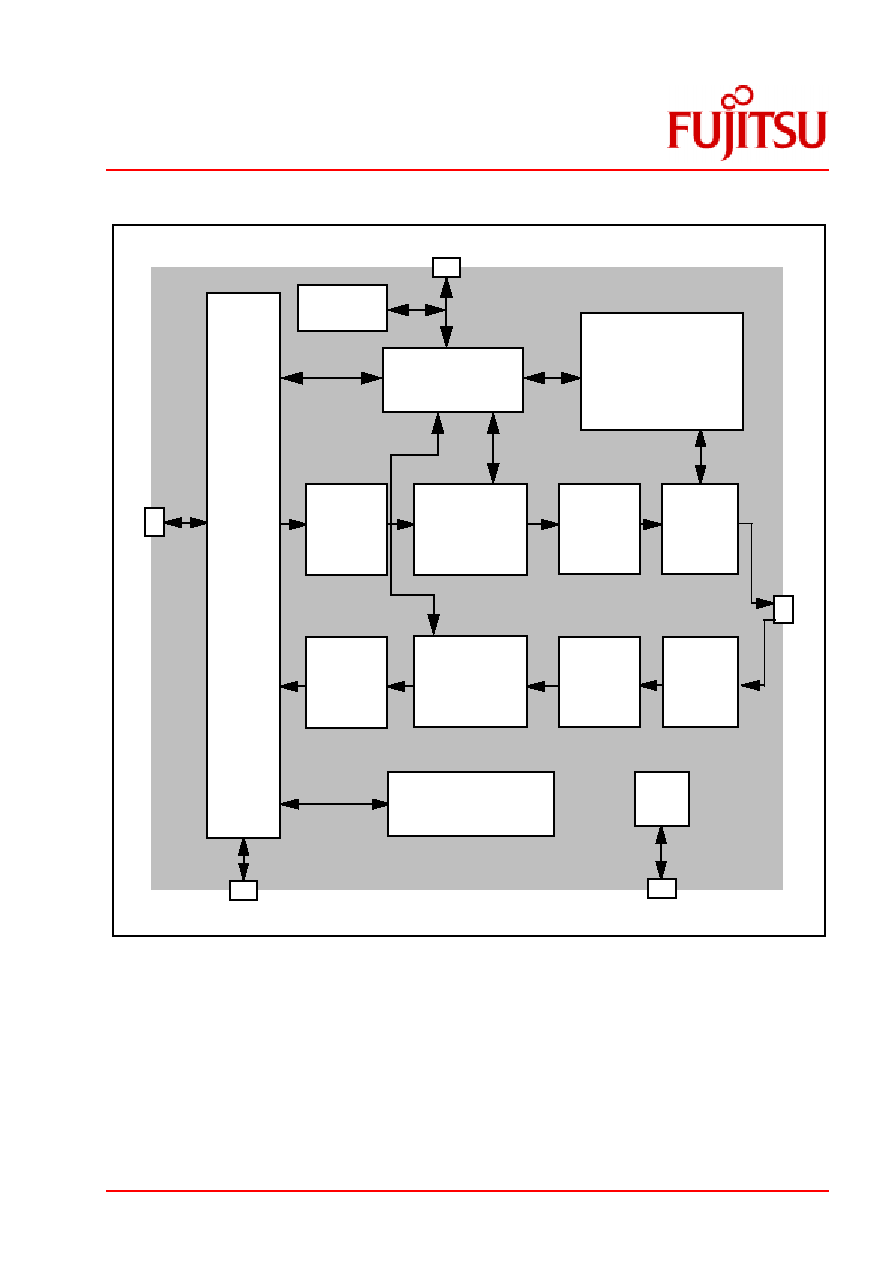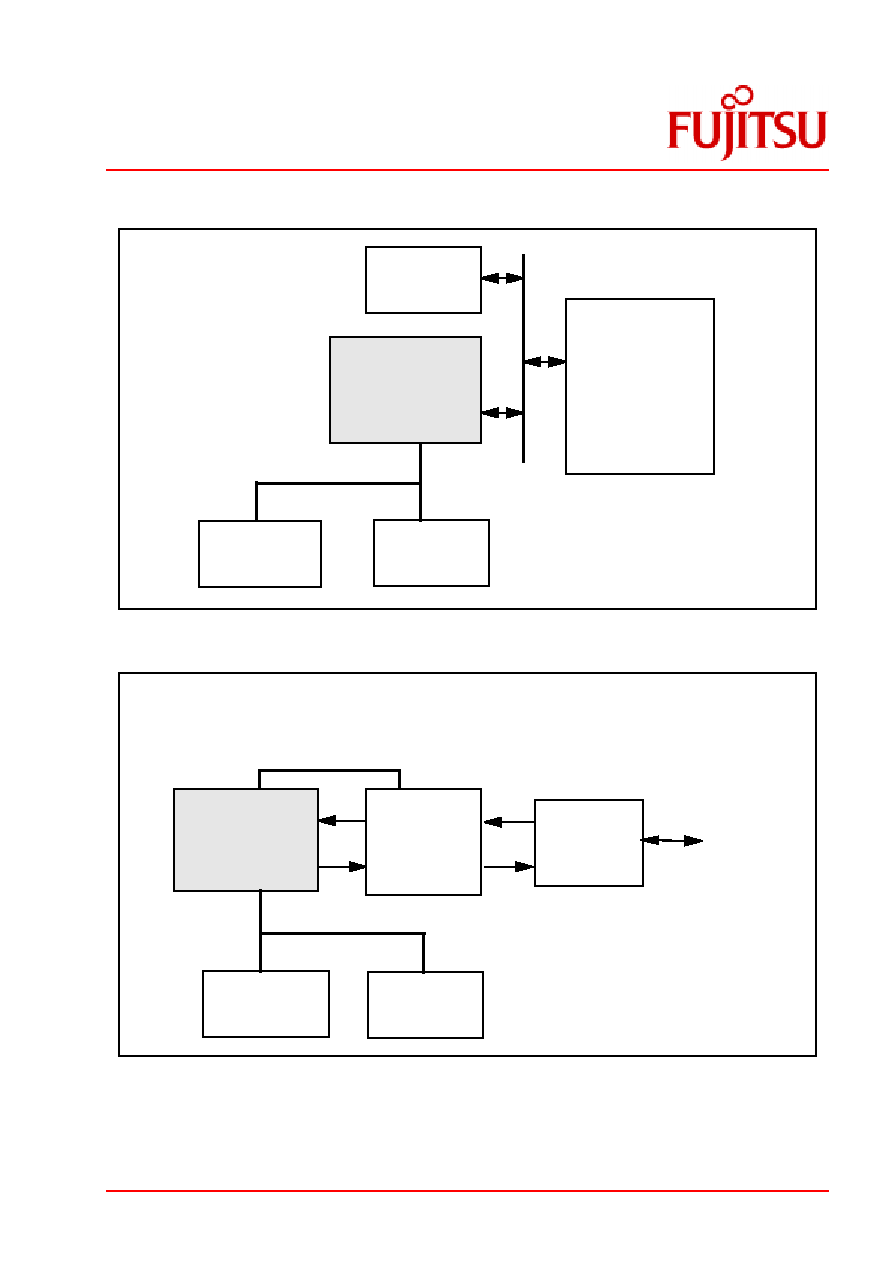 | –≠–ª–µ–∫—Ç—Ä–æ–Ω–Ω—ã–π –∫–æ–º–ø–æ–Ω–µ–Ω—Ç: MB86695 | –°–∫–∞—á–∞—Ç—å:  PDF PDF  ZIP ZIP |

MB86695
FireStreamTM50
ATM 52 Mbps SAR Device
Copyright © 2000 Fujitsu Microelectronics Europe GmbH
Page 1 of 7
Product Flyer
April 2000
Version 1.0
FML/NPD/FS50/FL/2359
FireStreamTM5
ATM 52 Mbps SAR Device
MB86695
The FireStream50 is a low cost ATM protocol controller
which autonomously terminates ATM Adaptation Layer
standard Type 5 (AAL5). ATM cells are received through a
UTOPIA
v2.01
compliant
interface.
Simultaneous
segmentation and reassembly can be achieved at an
average rate in excess of 52Mbps.
The device contains embedded memory to support 32
virtual circuits (VCs).
All ATM Forum traffic classes (ABR, VBR, CBR, UBR) are
supported with traffic management to ATM Forum TM4.0
specification for all 32 VCs.
The FireStream50 is ideally suited to many ATM
applications including ATM switches, home gateways,
integrated access devices, set-top boxes, routers and
adaptor cards.
Features
∑
Broadband ISDN Adaptation Layer standard Type 5 (AAL5)
∑
Simultaneous segmentation and reassembly on up to 32VCs
∑
ABR, VBR, CBR and UBR traffic classes with traffic management compliant to TM4.0
∑
Autonomous Resource Management (RM) cell handling
∑
33MHz 32-bit PCI (v2.1) interface supporting the 3.3V signalling environment, and tolerant to 5V
∑
Write-only interface for PDU handling with copy of SAR registers maintained in host memory
∑
Configuration through PCI slave port, PCI configuration optionally through serial EEPROM
∑
Support for scatter/gather mode
∑
Transparent ATM cell and cell payload modes (AAL0) with support for Operations and
Maintenance (OAM) cells
∑
8 bit, up to 52MHz UTOPIA v2.01 level1/2 compliant cell stream interface with master/slave
modes and optional HEC checking on receive
∑
Embedded memory, no external memory requirement
∑
16 bit Peripheral interface
∑
JTAG compliant to IEEE1149.1
∑
Fabricated in CMOS technology with CMOS/TTL compatible 5V tolerant I/O
∑
-40
∞
C to +85
∞
C Industrial temperature range
PLASTIC PACKAGE
SQFP208

April 2000 Version 1.0
FML/NPD/FS50/FL/2359
MB86695 FireStreamTM50 ATM 52 Mbps SAR Device
Copyright © 2000 Fujitsu Microelectronics Europe GmbH
Page 2 of 7
Figure 1 FireStream50 block diagram
General
A top level logic diagram of the FireStream50 is shown in Figure 1. The FireStream50
simultaneously supports autonomous segmentation and reassembly of user data packets on up to
32 virtual circuits (VCs). User data packets are transferred to and from shared data structure memory
using a high speed 32-bit PCI bus and transferred to and from the network using an 8-bit UTOPIA
interface.
High
Speed
DMA
Controller
ATM
Cell
Input
ATM
Cell
Output
Cell Input
Buffer
(3Cells)
Receive
Buffer
(24 Cells)
Reassembly and
Convergence
Sub-layer
Controller
Cell Output
Buffer
(3 Cells)
Transmit
Buffer
(4 Cells)
Segmentation
and
Convergence
Sub-layer
Controller
Local
Memory
Controller
JTAG
Traffic
Management
Controller
Internal
Registers
JTAG Interface
Peripheral Interface
Host Interf
ace (PCI)
UT
OPIA Interf
ace
Serial EEPROM Interface
Internal
RAM

April 2000 Version 1.0
FML/NPD/FS50/FL/2359
MB86695 FireStreamTM50 ATM 52 Mbps SAR Device
Copyright © 2000 Fujitsu Microelectronics Europe GmbH
Page 3 of 7
Adaptation Layer Support
The FireStream50 autonomously terminates the protocols involved in segmenting and reassem-
bling data streams conforming to ATM Adaptation Layer (AAL) Type 5 to I.363. Streaming and Mes-
sage Modes as defined for AAL5 are supported. In Message Mode, the Convergence Sublayer
payload (Service Data Unit) is considered to be the user data transmitted from or received into a
single entity - a single entity being regarded as one user data buffer or linked chain of user data buff-
ers. In Streaming Mode, the Convergence Sublayer payload is considered to be the user data trans-
mitted from or received into multiple entities separated in time. This allows a partial segmentation or
reassembly. The device recognises OAM and RM cells and separates them from the data stream.
The FireStream50 device supports two transparent modes (AAL0) with optional CRC-10 genera-
tion and checking. In transparent payload mode the 48 byte ATM cell payload is received or trans-
mitted transparently into or from SAR Memory. In transparent cell mode the complete ATM cell,
excluding the HEC, is received or transmitted transparently into or from SAR Memory.
Traffic Shaping
The FireStream50 supports autonomous traffic shaping functions for ABR, VBR, UBR and CBR
traffic. Traffic parameters are stored on a per-circuit basis in internal memory. A calendar algorithm
is used for traffic scheduling and has four priority levels which are independent of traffic type. ABR
support includes autonomous handling of RM cells. Transmitted FRM cells are dropped into the data
stream at the correct rate. Received BRM cells modify the associated VC's traffic parameters.
Received FRM cells are stored locally and automatically rescheduled for transmission.
Embedded Memory
Control structures are initialised by the host and then copied by the FireStream50 into internal
memory. These include circuit information such as VP/VC values and descriptor information such as
data pointers and buffer lengths. The FireStream50 then works on the local copy of these structures
and hence does not consume any further system bandwidth. The internal memory also contains
static and dynamic traffic parameters and pointers for the traffic scheduling algorithm.
Cell Stream Interface
The FireStream50 interfaces via a standard UTOPIA level 1 or level 2 interface. This 8-bit interface
which operates at up to 52MHz can be configured as an ATM or a PHY (master or slave) device
depending on the application. The HEC is inserted on transmit and checked on receive. A 52-byte
cell option is provided where the HEC is omitted.
PCI Master Interface
The FireStream50 has a high performance 32-bit PCI master interface, conforming to v2.1 of the PCI
specification. The programming interface has a "write-only" mode which minimizes PCI bus
occupancy by removing the need for the Host to make slave read accesses.
PCI Slave Interface
A simple PCI slave control/status port is used to configure the device. Its function includes the
Initialisation of the queue structures and the monitoring of cell and packet loss. An interrupt
mechanism is implemented to indicate queue updates and exception conditions.

April 2000 Version 1.0
FML/NPD/FS50/FL/2359
MB86695 FireStreamTM50 ATM 52 Mbps SAR Device
Copyright © 2000 Fujitsu Microelectronics Europe GmbH
Page 4 of 7
Circuit Initialisation
Circuits are initialised for both transmit and receive by placing an entry on a high or low priority
Transmit Pending Queue or onto an on-chip queue. This entry points to configuration information. A
Status Queue is used to inform the user that the operation has been completed.
Transmit Operation
Transmit operation is initiated using a simple queue structure. A buffer containing part or all of a
packet's data is scheduled by placing a Transmit Descriptor pointer on the high or low priority
Transmit Pending Queue. The FireStream50 links queued descriptors for the same VC into a list.
Data is then segmented under the control of the traffic scheduler into cells. The data pointer is
contained in the Transmit Descriptor. When a buffer is exhausted it is returned to the host by putting
the Transmit Descriptor pointer on a Release Queue.
Receive Operation
On receiving ATM cells the FireStream50 takes a buffer from one of eight simple Buffer Free Pools.
Each pool forms a linked list and buffers are allocated to the device by linking Receive Descriptors
onto the list. Each pool may use a different buffer size. Receive Circuits can be allocated to one of
these pools. Alternatively the device may be configured so that Receive Circuits use an initial buffer
from one pool followed by subsequent buffers from another pool to reassemble a packet. This
maximizes memory efficiency. Receive Circuits can have a low-priority discard mode where free
buffers will not be allocated while the number of free entries is below a programmable threshold. This
improves robustness of the system under heavy receive traffic loading by preventing the free pools
under running. When buffers are completed they are returned to the host by putting the Receive
Descriptor identifier on one of four Buffer Ready Queues.
JTAG
A JTAG port Boundary Scan port provides support for PCB production test.

April 2000 Version 1.0
FML/NPD/FS50/FL/2359
MB86695 FireStreamTM50 ATM 52 Mbps SAR Device
Copyright © 2000 Fujitsu Microelectronics Europe GmbH
Page 5 of 7
Figure 2 ATM switch Port designed around the FireStream50
Figure 3 ATM Terminal equipment based around the FireStream50
DSLAM
Switch Matrix
Host CPU
System Memory
FireStream50
MB86695
FireStream50 UTOPIA
interface in Slave Mode
shares switch port with
PHY devices
PHY device
PCI
FireStream50
MB86695
PHY Device
Line Driver
&
Receive
Equalisation
User Network
Interface
(UNI)
System Memory
Host CPU
PCI




